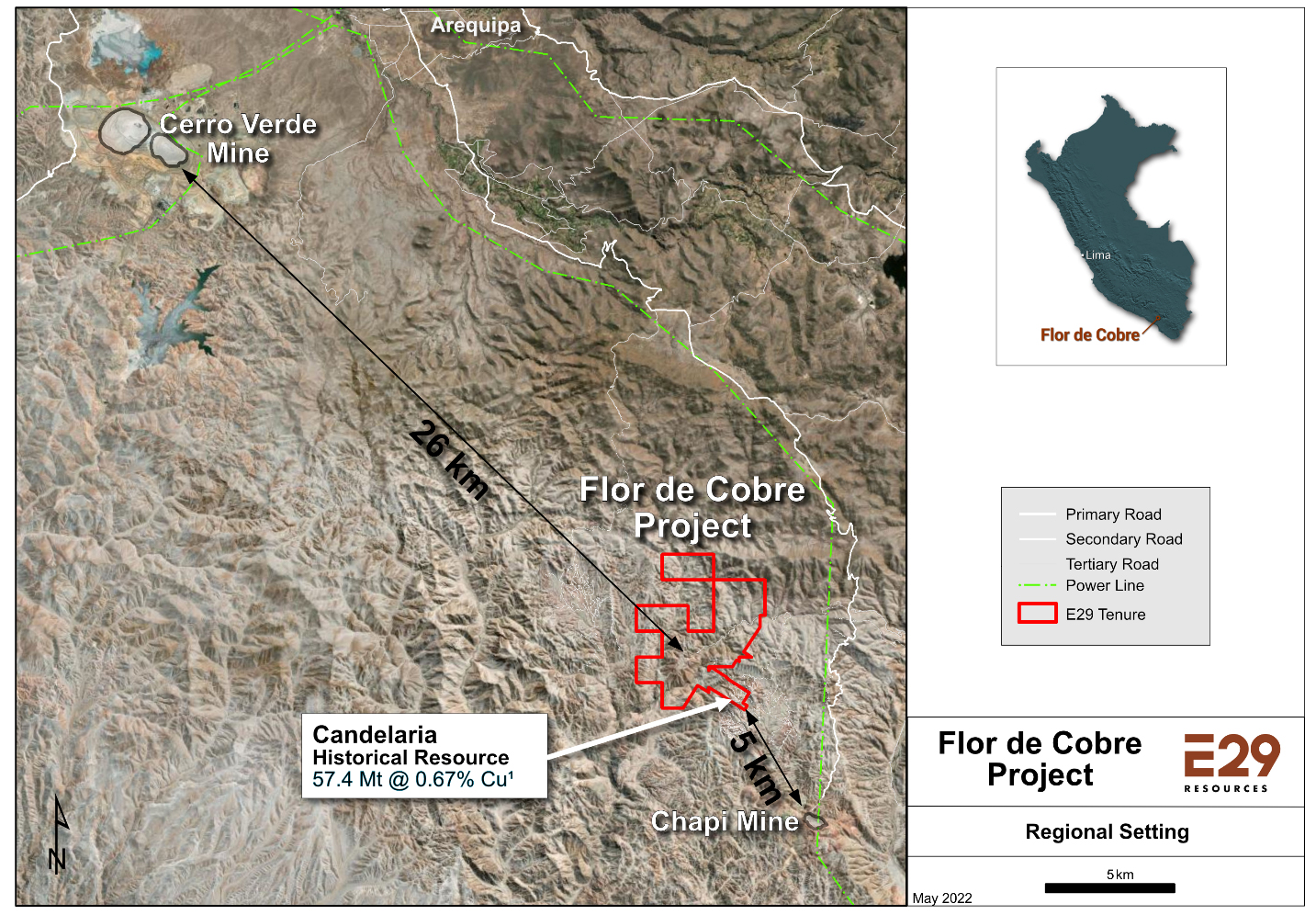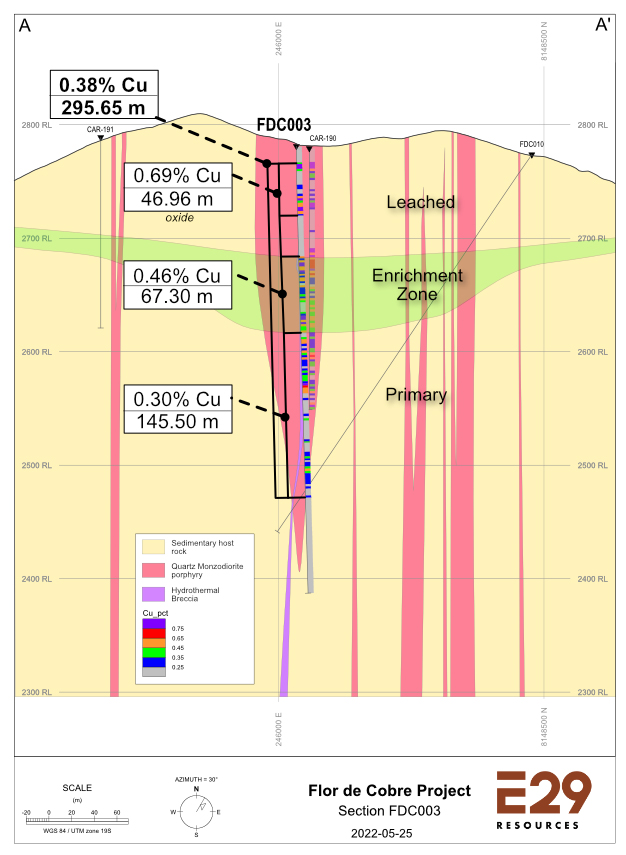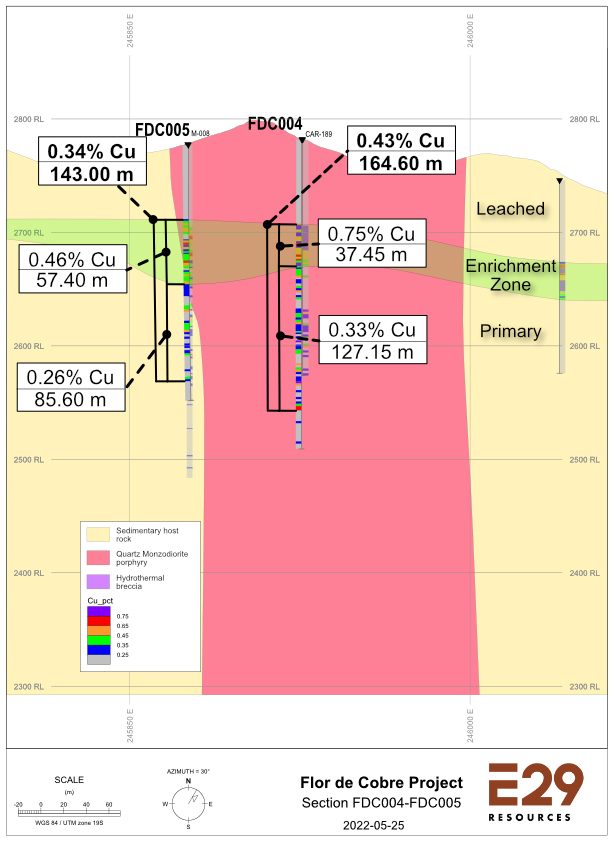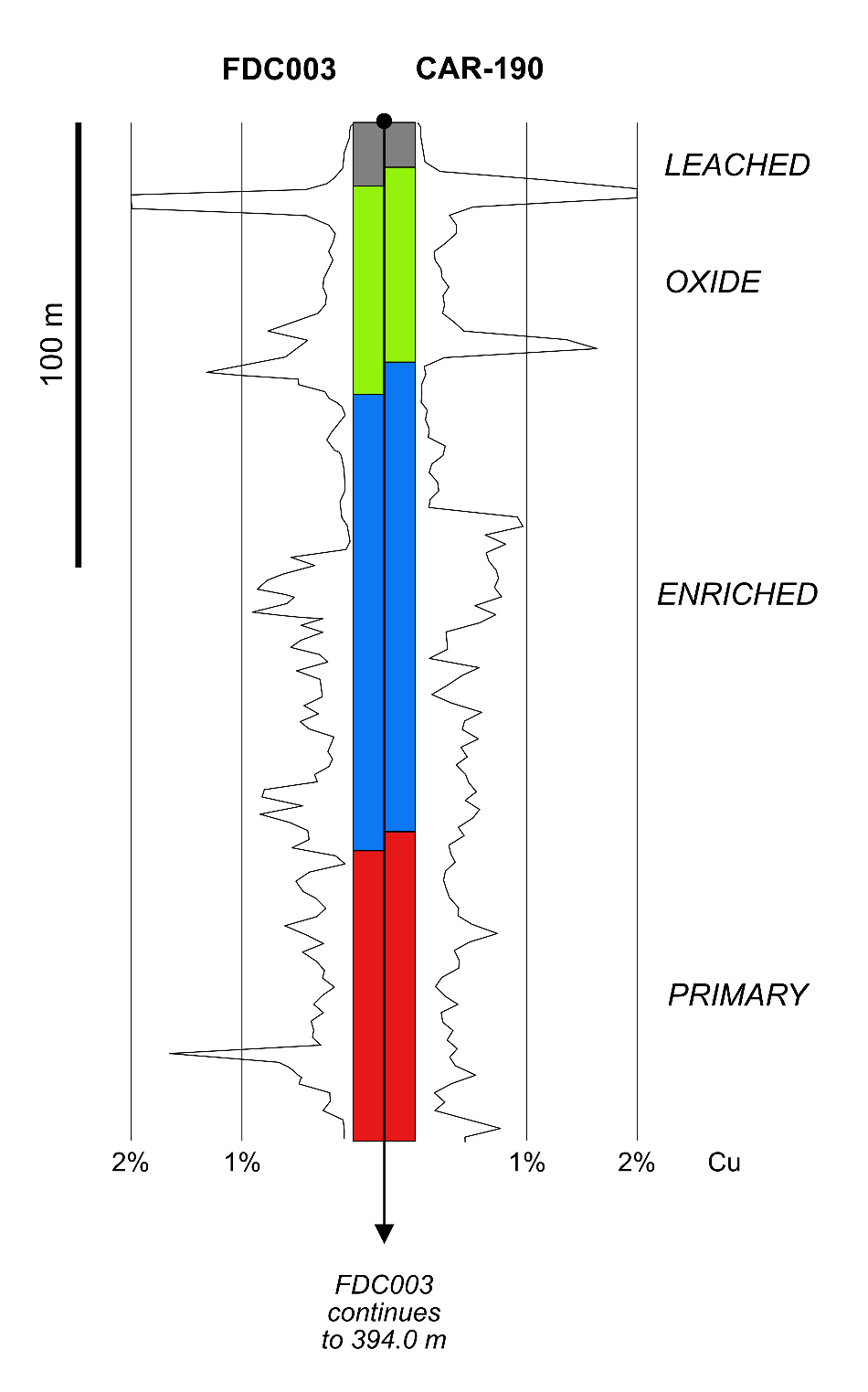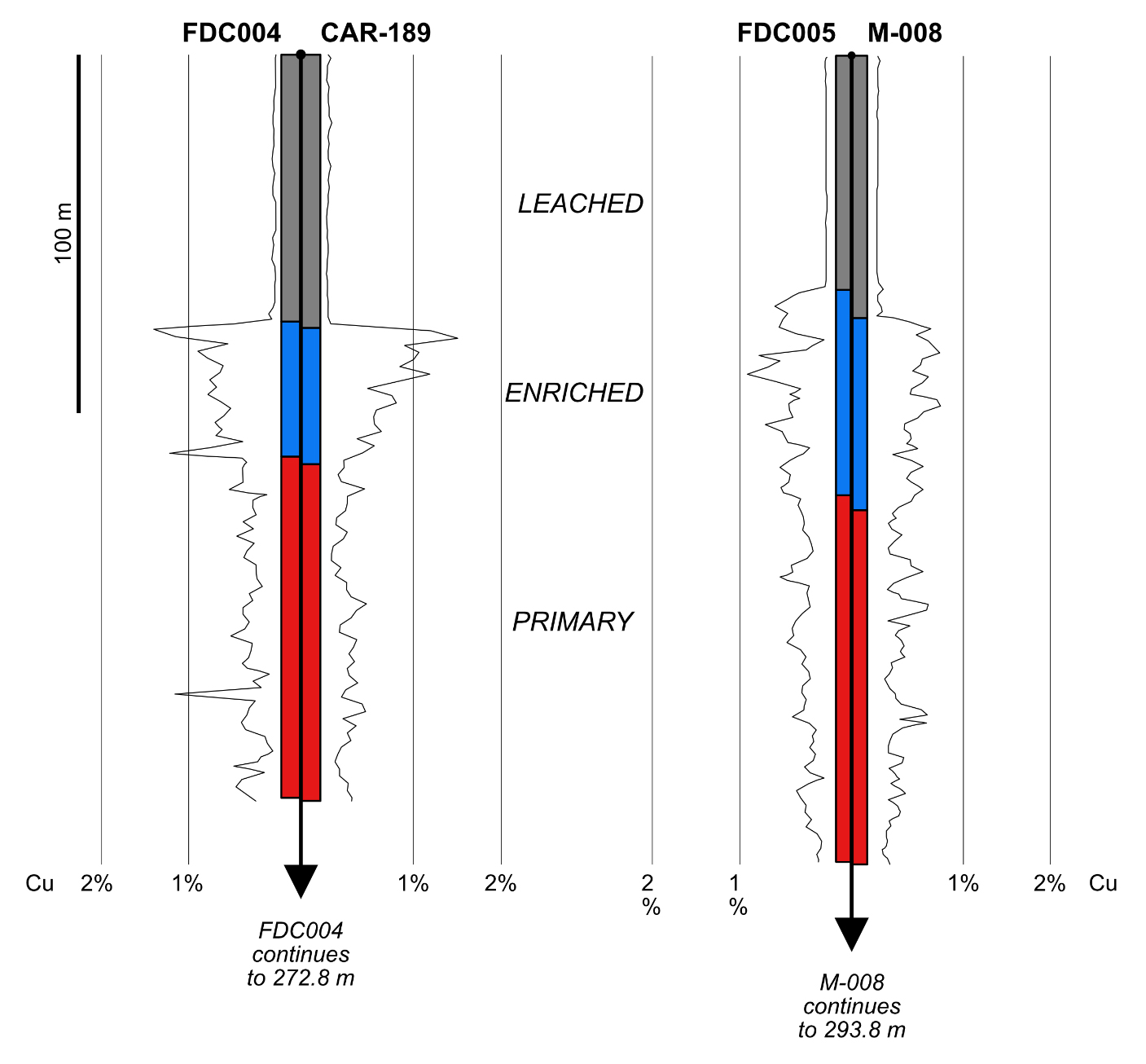Element 29 Further Confirms Past Drill Results Used In Historical Copper Resource Estimate At Flor De Cobre
Vancouver, Canada, June 1, 2022 – Element 29 Resources Inc. (“Element 29” or the “Company”) (TSX-V: ECU | OTCQB: EMTRF) announces results of three additional drill holes from the recently completed 4,500 metre (“m”), twelve-hole drill program at the Flor de Cobre Copper Project (“Flor de Cobre” or “the Project”) located in southern Peru (Figure 1).
Steve Stakiw, Element 29’s President and CEO comments, “These latest Flor de Cobre drill results continue to demonstrate strong correlation with historical holes and adds confidence to our planned initial mineral resource estimate which we expect to complete following the receipt of the remaining results. Additionally, we have continued to encounter copper mineralization significantly deeper than in the historical holes, which supports the potential for primary sulphide resources at depth.”
Flor de Cobre Drilling Highlights
- These additional holes continue to show excellent correlation with their respective historical holes. The position and thickness of enrichment intersected by the twinned holes is similar to their historical counterparts.
- Drill hole FDC003 intersected 295.65 m of 0.38% copper (“Cu”) including 46.95 m of 0.69% Cu as oxides and 67.30 m of 0.46% Cu in the enriched sulphide zone followed by 145.50 m of 0.30% Cu in the primary sulphide zone below.
- Drill hole FDC004 intersected 164.60 m of 0.43% Cu including 37.45 m of 0.75% Cu in an enriched sulphide zone followed by 127.15 m of 0.33% Cu in the primary sulphide zone below.
- Drill hole FDC005 intersected 143.00 m of 0.34% Cu including 57.40 m of 0.46% Cu in an enriched sulphide zone followed by 85.60 m of 0.26% Cu in the primary sulphide zone below.
The objectives of the current drill program are to verify the historical resource estimate of 57.4 million tonnes of 0.67% Cu associated with a supergene enrichment blanket formed on the Candelaria porphyry (“Candelaria”) and to explore for primary Cu sulphide mineralization underneath the enrichment blanket to depths of over 500 m.
The source of the historical resource estimate is the report Rio Amarillo Mining Ltd. – Candelaria Porphyry Copper Deposit, Arequipa, Peru, Mineral Reserve Estimate, 1996. This historical resource is relevant to Flor de Cobre as it suggests supergene-enriched mineralization of interest may be present at Candelaria. However, the Company cautions that the parameters, assumptions, and methods used to calculate the historical estimate are unknown. Additionally, the historical estimate does not use resource categories described in CIM Definition Standards for Mineral Resources and Mineral Reserves (2014). It is also unclear what portion of this historical resource estimate is within the current Flor de Cobre property configuration. A Qualified Person has not done sufficient work to classify the historical estimate as a current mineral resource and it is unclear if the current work plan will confirm the resource. For these reasons, the historical resource has not been verified by the Company and the Company is not treating the historical estimate as a current mineral resource.
Table 1. Results of drill holes FDC003, FDC004, and FDC005. Grades are length-weighted averages of samples within the intervals shown.
| Hole | From (m) |
To (m) |
Length2 (m) |
Cu (%) |
Mo (%) |
Ag (ppm) |
As (ppm) |
CuEq1 (%) |
| FDC003 | 14.35 | 310.00 | 295.65 | 0.38 | 0.009 | 1.1 | 111 | 0.42 |
| oxide | 14.35 | 61.30 | 46.95 | 0.69 | 0.005 | 0.7 | 16 | 0.72 |
| enriched | 97.20 | 164.50 | 67.30 | 0.46 | 0.018 | 0.6 | 31 | 0.53 |
| primary | 164.50 | 310.00 | 145.50 | 0.30 | 0.005 | 1.3 | 197 | 0.33 |
| FDC004 | 74.40 | 239.00 | 164.60 | 0.43 | 0.006 | 0.7 | 12 | 0.46 |
| enriched | 74.40 | 111.85 | 37.45 | 0.75 | 0.003 | 0.8 | 19 | 0.77 |
| primary | 111.85 | 239.0 | 127.15 | 0.33 | 0.007 | 0.7 | 10 | 0.36 |
| FDC005 | 65.40 | 208.40 | 143.00 | 0.34 | 0.004 | 1.3 | 59 | 0.37 |
| enriched | 65.40 | 122.80 | 57.40 | 0.46 | 0.004 | 0.7 | 19 | 0.48 |
| primary | 122.80 | 208.40 | 85.60 | 0.26 | 0.004 | 1.6 | 86 | 0.29 |
1 Copper equivalent grades (CuEq) are for comparative purposes only. Calculations are uncut and recovery is assumed to be 100% as metallurgical data is insufficient to allow for estimation of metal recoveries. Copper equivalence (CuEq %) is calculated as: CuEq (%) = Cu (%) + [3.55 × Mo (%)] + [0.0095 × Ag (g/t)], utilizing metal prices of Cu - US$3.34/lb, Mo - US$11.86/lb and Ag - US$21.87/oz. Metal prices are based on a 2-year average of monthly LME metal prices.
2 Intervals are downhole drilled core lengths. Drilling data to date is insufficient to determine true width of mineralization. Assay values are uncut.
The Company’s drill program consists of approximately 4,500 m of diamond drilling centred on the Candelaria porphyry complex (Figure 2). A total of 2,180 m was allocated to twin nine historical drill holes to verify the accuracy of existing historical geochemical assays and drill logs (Table 3). These nine drill holes are interpreted to represent 70% of the Cu contained in the historical copper resource estimate and potentially verify the assay results and provide the level of confidence needed for completion of a planned resource estimate that meets CIM best practice guidelines. The first three drill holes of the 2022 Flor de Cobre drill program included 349 m of 0.77% Cu, including 123 m of 1.42% Cu (refer to April 19, 2022 press release). The remaining 2,320 m in three drill holes was allocated to the drill program will test the primary copper sulphide mineralization potential below the supergene enrichment blanket to depths of more than 500 m.
Drill hole FDC003 was collared in an early phase of quartz monzodiorite porphyry belonging to the Candelaria porphyry complex, as shown in Figure 3 and intersected 46.95 m of 0.69% Cu in an oxide zone above a chalcocite-dominated enrichment zone returning 67.3 m of 0.46% Cu. Primary sulphide mineralization with a pyrite-chalcopyrite assemblage extended beneath the enrichment zone and returned 145.5 m of 0.30% Cu. Strong potassic alteration overprinted by sericite-pyrite alteration continued to the end of the hole at 394 m.
FDC004 intersected the strongly potassic altered, early quartz monzodiorite porphyry through its entire length. Chalcocite-dominated enrichment was encountered at 74.4 m below surface and returned 37.45 m of 0.75% Cu followed by 127.15 m of 0.33% Cu of primary sulphide. Locally elevated copper grades are present in the broader primary sulphide interval (see Image 1).
The southern edge of the early quartz monzodiorite porphyry was cored by FDC005, which intersected an enrichment zone of 57.4 m of 0.46% Cu followed by primary sulphides returning 85.6 m of 0.26% Cu. Alternating intervals of early quartz monzodiorite porphyry, later quartz monzodiorite porphyry, hydrothermal breccia, and sedimentary host rocks were intersected.
Comparison with Historical Data
The primary objective of the drilling program is to verify results from historical drilling, which was a combination of core and reverse circulation drilling completed in the mid-1990’s by Rio Amarillo and Phelps Dodge. Materials from these drilling programs are unavailable and prevented a Qualified Person from verifying copper geochemical results. Therefore, twinning selected holes is required to verify results from historical drilling such that it can be used in future resource estimation. Furthermore, analysis of other elements of interest such as molybdenum and silver were incomplete in the historical database. Multi-element analysis from twinned holes provides an opportunity to investigate a possible economic contribution of these constituents.
The third hole of the 2022 program (FDC003) twinned historical reverse circulation drill hole CAR-190, FDC004 twinned historical reverse circulation hole CAR-189, and FDC005 twinned historical core hole M-008. Results from the latest batch of holes were very similar to their historical twins both in Cu grades and the position of the enrichment zone. Graphic representations of the twin and historical drilling results are plotted in Figures 5 and 6.
Table 2. Comparison of intervals from the historical drill holes CAR-190, CAR-189, and M-008 with twinned holes FDC003, FDC004, and FDC005.
| FDC003 | CAR-190 | |||||||||
| From | To | Length | Cu% | From | To | Length | Cu% | Zone | ||
| 14.35 | 230.00 | 215.65 | 0.42 | 12.00 | 230.00 | 218.00 | 0.47 | Total | ||
| 14.35 | 61.30 | 46.95 | 0.69 | 12.00 | 54.00 | 42.00 | 0.82 | Oxide | ||
| 97.20 | 164.50 | 67.30 | 0.46 | 88.00 | 160.00 | 72.00 | 0.52 | Enriched | ||
| 164.50 | 230.00 | 65.50 | 0.36 | 160.00 | 230.00 | 70.00 | 0.36 | Primary | ||
| FDC004 | CAR-189 | |||||||||
| From | To | Length | Cu% | From | To | Length | Cu% | Zone | ||
| 74.40 | 207.00 | 132.60 | 0.44 | 76.00 | 208.00 | 132.00 | 0.39 | Total | ||
| 74.40 | 111.85 | 37.45 | 0.75 | 76.00 | 112.00 | 36.00 | 0.79 | Enriched | ||
| 111.85 | 207.00 | 95.15 | 0.31 | 112.00 | 208.00 | 96.00 | 0.24 | Primary | ||
| FDC005 | M-008 | |||||||||
| From | To | Length | Cu% | From | To | Length | Cu% | Zone | ||
| 65.40 | 208.40 | 143.00 | 0.34 | 73.15 | 208.65 | 135.50 | 0.35 | Total | ||
| 65.40 | 122.80 | 57.40 | 0.46 | 73.15 | 127.00 | 53.85 | 0.48 | Enriched | ||
| 122.80 | 208.40 | 85.60 | 0.26 | 127.00 | 208.65 | 81.65 | 0.27 | Primary | ||
The Company continues to progress drill permitting on the Atravesado porphyry target (“Atravesado”) in preparation for initial drill-testing of a priority porphyry target supported by coincident outcrop geology, surface geochemistry, and geophysical responses. Atravesado is located approximately 2 kilometres (“km”) northwest of Candelaria and is a 1.5 km x 1.6 km circular zone characterized by outcropping copper oxide mineralization in association with quartz vein stockworks and potassic alteration (Figure 2). Late-mineral porphyry dikes are also mapped within the target area.
Analytical Quality Control & Quality Assurance
Candelaria Resources S.A.C., a wholly owned subsidiary of Element 29 Resources Inc., supervises drilling and carries out sampling of HQ and NQ core. Logging and sampling are completed at a secured Company facility situated on the Flor de Cobre project site. Sample intervals are nominally 2 m long. Drill core is cut in half using a rotary diamond blade saw and samples are sealed on site before transportation to the ALS Peru S.A.C. sample preparation facility in Arequipa by Company vehicles and staff. Prepared samples are sent to Lima by ALS Peru S.A.C. for analysis. ALS Peru S.A.C. is an independent laboratory. Samples are analyzed for 35 elements using an Aqua Regia digestion and ICP-AES analysis (ME-ICP41). Samples reporting over limits are analyzed by Aqua Regia digestion with ICP-AES finish (ME-OG46). ALS meets all requirements of International Standards ISO/IEC 17025:2005 and ISO 9001:2015 for analytical procedures.
Element 29 employs an independent, internal quality assurance/quality control program that includes insertion of duplicate, blank, and certified reference samples at the field site. The Company is not aware of any drilling, sampling, recovery, or other factors that could materially affect the accuracy or reliability of the data reported.
Qualified Person
The scientific and technical content of this press release has been reviewed and approved by Paul J. Johnston (PhD, P.Geo), Vice President of Exploration for Element 29 and is a “Qualified Person” as defined in National Instrument 43-101 Standards of Disclosure for Mineral Projects.
Neither the TSX Venture Exchange nor its Regulation Service Provider (as that term is defined in the policies of the TSX Venture Exchange) accepts responsibility for the adequacy or accuracy of this press release.
Table 3: List of twelve drill holes forming the 2022 Flor de Cobre drilling program. Nine of the twelve drill holes are designed to twin historical drill holes. The coordinates, depth, orientation, and hole type of the historical holes are shown. Drill holes FDC001 through FDC012 are complete, with results pending for FDC006 through FDC012.
| Hole ID | Hole ID (historical) |
East | North | Elev (m) |
Length (m) |
Azimuth (degrees) |
Dip (degrees) |
Historical Hole Type |
| FDC001 | K-008 | 245888 | 8148409 | 2776 | 350 | 0 | -90 | DDH |
| FDC002 | CAR-188 | 245812 | 8148419 | 2800 | 256 | 0 | -90 | RC |
| FDC003 | CAR-190 | 246004 | 8148314 | 2791 | 230 | 0 | -90 | RC |
| FDC004 | CAR-189 | 245911 | 8148317 | 2793 | 208 | 0 | -90 | RC |
| FDC005 | M-008 | 245894 | 8148213 | 2786 | 294 | 0 | -90 | DDH |
| FDC006 | K-006 | 245719 | 8148358 | 2825 | 231 | 0 | -90 | DDH |
| FDC007 | K-010 | 246086 | 8148405 | 2801 | 257 | 0 | -90 | DDH |
| FDC008 | I-008 | 245937 | 8148571 | 2752 | 147 | 0 | -90 | DDH |
| FDC009 | CAR-186 | 246212 | 8148415 | 2772 | 211 | 0 | -90 | RC |
| FDC010 | NA | 245610 | 8148517 | 2743 | NA | 210 | -55 | NA |
| FDC011 | NA | 246104 | 8148478 | 2789 | NA | 44 | -55 | NA |
| FDC012 | NA | 246004 | 8148314 | 2791 | NA | 300 | -55 | NA |
Coordinates are in WGS84 zone 18S UTM
About Flor de Cobre
Flor de Cobre is a porphyry copper exploration project that contains the Candelaria and the recently outlined Atravesado porphyry copper targets. The property is in the Southern Peru Copper Belt and is 5 km northwest of Nexa Resources’ Chapi mine and 26 km southeast of the Cerro Verde mine owned by Freeport-McMoRan, Sumitomo Metal Mining, and Compañía de Minas Buenaventura. Candelaria is a classic Andean porphyry system with primary copper sulphide mineralization associated with a multi-phase quartz monzonite porphyry complex. Weathering redistributed primary mineralization into a sub-horizontal enrichment blanket containing secondary copper oxide and sulphide minerals at the base of a hematitic leached cap. Remnants of the upper jarositic component of the leached cap overlying the hematitic cap are preserved on the higher hill tops around the Candelaria prospect. Atravesado is a porphyry copper exploration target located about 2 km northwest of Candelaria. An IP/Resistivity geophysical survey completed in 2020 outlined a core of moderate resistivity measuring 1.5 x 1.6 km that coincides with widespread copper oxide mineralization, strong copper geochemistry, and late-stage quartz monzodiorite porphyry dikes. The resistive core is surrounded by a high-chargeability halo corresponding with weathered quartz-sericite-pyrite alteration.
About Element 29 Resources Inc.
Element 29 Resources Inc. is an emerging copper exploration and development company focused on advancing its portfolio of Peruvian projects towards development in one of the world’s lower-risk mining jurisdictions. Element 29’s growth strategy is led by our strong board and management, who have a proven track record of discovery and delivering significant value to our shareholders.
The Company’s principal objective is to explore and develop its flagship Flor de Cobre porphyry Cu-Mo project located in southern Peru, 26 km southeast from Freeport-McMoRan’s Cerro Verde Cu-Mo mine. At the same time, the Company intends to build on its potential copper inventory with continued exploration of its Flor de Cobre project as well as its remaining 22,000 hectares of mining concessions in Peru, including the recently discovered Elida porphyry copper-molybdenum-silver system located 85 km from the coast in central Peru. Both projects are well located for potential mine development and will benefit from nearby infrastructure including roads, powerlines, ports, water, and a skilled workforce.
More information is available at www.e29copper.com.
For more information:
David Jan
Investor Relations
1-888-246-7881
[email protected]
Forward Looking Statements
This press release contains certain forward-looking information and forward-looking statements within the meaning of applicable Canadian securities legislation (collectively, “Forward-looking Statements”). All statements, other than statements of historical fact, constitute Forward-looking Statements. Words such as “will”, “intends”, “proposed” and “expects” or similar expressions are intended to identify Forward-looking Statements. Forward looking Statements in this press release include statements related the Company’s resource properties, and the Company’s plans, focus and objectives.
Forward-looking Statements involve various risks and uncertainties and are based on certain factors and assumptions. There can be no assurance that such statements will prove to be accurate, and actual results and future events could differ materially from those anticipated in such statements. Important factors that could cause actual results to differ materially from the Company's expectations include uncertainties related to fluctuations in copper and other commodity prices, uncertainties inherent in the exploration of mineral properties, the impact and progression of the COVID-19 pandemic and other risk factors set forth in the Company’s prospectus under the heading “Risk Factors”. The Company undertakes no obligation to update or revise any Forward-looking Statements, whether as a result of new information, future events or otherwise, except as may be required by law. New factors emerge from time to time, and it is not possible for Element 29 to predict all of them or assess the impact of each such factor or the extent to which any factor, or combination of factors, may cause results to differ materially from those contained in any Forward-looking Statement. Any Forward-looking Statements contained in this press release are expressly qualified in their entirety by this cautionary statement.
Figure 1. Regional setting of the Flor de Cobre Project is in the Southern Peru Copper Belt, between the Cerro Verde and Chapi mines. The project is at a moderate elevation of less than 2,700 m, is road accessible, and is close to excellent infrastructure for mine development and operation.
1 The source of the historical resource estimate is a press release issued by Rio Amarillo Mining Ltd. dated November 15, 1996 (Rio Amarillo Mining Ltd., November 15th, 1996: Aija Property Drill Results). This historical resource is relevant to Flor de Cobre as it suggests supergene-enriched mineralization of interest may be present at Candelaria. However, the Company cautions that the parameters, assumptions, and methods used to calculate the historical estimate are unknown. Additionally, the historical estimate does not use resource categories described in CIM Definition Standards for Mineral Resources and Mineral Reserves (2014). It is also unclear what portion of this historical resource estimate is within the current Flor de Cobre property configuration. A Qualified Person has not done sufficient work to classify the historical estimate as a current mineral resource, and it is unclear what work might be required to confirm the resource. For these reasons, the historical resource has not been verified by the Company and the Company is not treating the historical estimate as a current mineral resource.
Figure 2. Simplified geology map of the southeastern end of the Flor de Cobre concessions illustrating the Candelaria porphyry complex. Drill hole locations of the 2022 drill program and historical drill holes are shown. The positions of sections containing holes FDC003, FDC004, and FDC005 are indicated with white dashed lines.
Figure 3. Section A-A' showing the position of FDC003, which is twinning historical hole CAR-190. Both holes were collared vertically. Both holes intersected Cu oxide mineralization within the leached capping above the enriched sulphide zone.
Figure 4. Section B-B’ showing the position of FDC004 and FDC005, which are twinning historical holes CAR-189 and M-008. Both holes were collared vertically.
Figure 5. Graphic comparison of results from FDC003 and historical hole CAR-190. There were small differences in the position of the oxide and enrichment zone boundaries. The twinned hole was positioned approximately 2 m away from the historical hole. Primary mineralization continued to 310 m in FDC003, whereas the historical reverse circulation hole was drilled to 230 m.
Figure 6. (a) Graphic comparison of results from FDC004 and historical reverse circulation hole CAR-189. There were small differences in the position of the enrichment zone boundaries. FDC004 hole was positioned approximately 2 m away from the historical hole. Primary mineralization continued to 239 m in FDC004, whereas the historical reverse circulation hole CAR-189 was drilled to 208 m and ended in mineralization. (b) Graphic comparison of results from FDC005 and historical core hole M-008. The lower enrichment boundaries are based on the logged abundance of chalcocite, which declines abruptly at the base of enrichment.
Figure 7. The Atravesado porphyry target characterized by a low resistivity low contrast, anomalous copper geochemistry, potassic alteration and associated quartz vein stockworks. Phyllic alteration correlates with zones of high chargeability. The Candelaria target area is located 2.5 km to the southeast.
Image 1: Mineralized early quartz monzodiorite porphyry intersected in FDC004 at 238.8 m from a 2 m sample interval returning 0.697% Cu, 0.0014% Mo, and 1.5 g/t Ag. Multiple generations of early quartz veinlets have thin hydrothermal potassium feldspar halos. Dark, biotite-chalcopyrite veins cut the quartz veinlets. Primary mafic minerals are replaced by secondary biotite and primary feldspar minerals are partially replaced by hydrothermal potassium feldspar. Disseminated chalcopyrite is deposited with secondary biotite.


